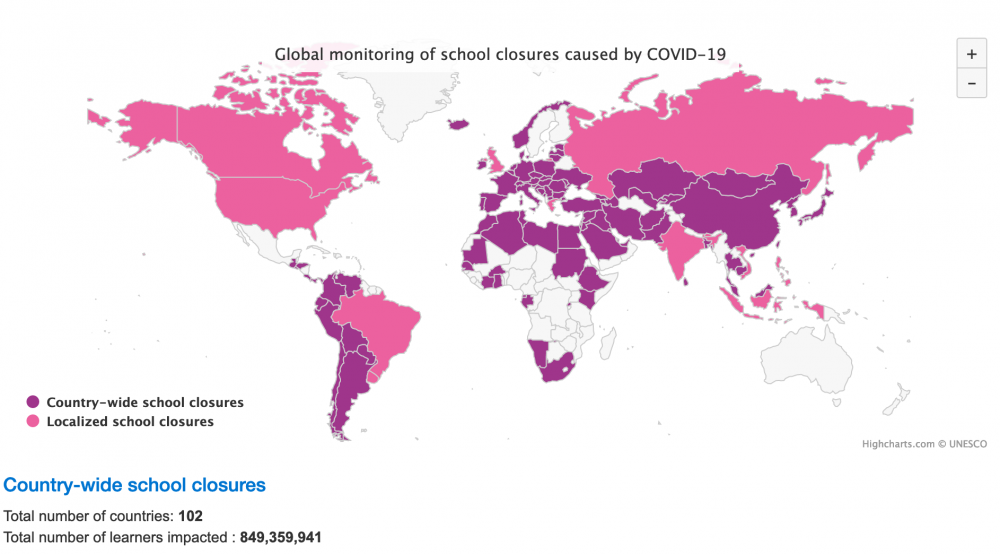Education, just like everything else has been severely affected by the coronavirus.
At my university, the teachers who had experience with online teaching and tools were proactive in helping colleagues adapt their courses. Having taught a few online classes and discovered that they can make creative use of the technology, many teachers will be changed forever. We expect that even those who go back to teaching in a traditional classroom will incorporate some of the online tools that they are now learning to use and this will be the same all over the world.
In Italy, the International School of Monza is part of the world’s biggest educational technology (edtech) experiment in history. The school is still running as teachers teach via video conferencing every day. Kids participate using Padlet, a virtual post-it note system that lets students share ideas; and Flipgrid, which lets teachers and students create short videos to share. Students do individual work, group work, and confer with teachers when needed and teachers use Microsoft Teams instead of email.
Software like Microsoft Teams allows teachers to see students as they are writing. That allows for real-time feedback, rather than waiting for the work to be completed. Some students who shied away from participation are stepping up; the quieter and more introverted students can participate more because they are not being seen by their peers.
With 1.5 Billion students out of school and hundreds of millions attempting to learn solely online, the crisis will reshape schools, the idea of education, and what learning looks like in the 21st century.
But as tech connects people in their homes, its limitations for learning are on display for all the world to see.
Moving the world’s students online has starkly exposed deep inequities in the education system, from the shocking number of children who rely on school for food and a safe environment, to a digital divide in which kids without devices or reliable internet connections are cut off from learning completely. According to the Organisation for Economic Co-operation and Development data in over 95% of students in Europe have a computer to use for their work but only 34% in Indonesia do.
Schools face a difficult choice: if they don’t teach remotely, all of their students miss out on months of curriculum. If they do, a sizable group of already disadvantaged students will be left out and will fall even farther behind.
This crisis is a stark reminder of the critical importance of schools and academies not just as a place of learning, but of socialization, care and coaching, of community and shared space not things that can be easily incorporated with technology.
La Educación, al igual que todo, se ha visto gravemente afectada por el coronavirus.
En mi universidad, los maestros que tienen experiencia con la enseñanza y las herramientas en línea fueron proactivos en ayudar a sus colegas a adaptar sus cursos. Habiendo enseñado algunas clases en línea y descubierto que pueden hacer un uso creativo de la tecnología, muchos maestros usaran estos cambios para siempre. Esperamos que incluso aquellos que vuelvan a enseñar en un aula tradicional, incorporen algunas de las herramientas en línea que ahora están aprendiendo a usar y seguramente pase en todo el mundo.
En Italia, ‘The International School of Monza’ es parte del experimento de tecnología educativa (edtech) más grande del mundo en la historia. La escuela sigue funcionando mientras los maestros enseñan a través de videoconferencia todos los días. Los niños participan usando Padlet: es un sistema virtual de notas post-it, que permite a los estudiantes compartir ideas y Flipgrid: Es una plataforma que permite a maestros y estudiantes crear videos cortos para compartir. Los estudiantes realizan trabajos individuales, grupales y consultan con los maestros cuando es necesario y los maestros usan Microsoft Teams en lugar de correo electrónico.
Así mismo,Software como Microsoft Teams permite a los maestros ver a los estudiantes mientras escriben. Eso permite comentarios en tiempo real, en lugar de esperar a que se complete el trabajo. Para los estudiantes con menos participación en las clases convencionales se han intensificado las oportunidades, ya que al pensar que sus compañeros no los pueden ver, en las clases on-line ya no son tan introvertidos o callados.
Con 1.500 millones de estudiantes sin escolarizar y cientos de millones intentando aprender únicamente en línea, la crisis reestructurará las escuelas, la idea de la educación y el aspecto del aprendizaje en el siglo XXI.
Sin embargo, a medida que la tecnología conecta a las personas en sus hogares, sus limitaciones para el aprendizaje se evidencian ante todo el mundo.
Trasladar a los estudiantes al mundo en línea ha puesto de manifiesto profundas desigualdades en el sistema educativo, desde la sorprendente cantidad de niños que dependen de la escuela para la alimentación y un entorno seguro, hasta una brecha digital en la que los niños sin dispositivos o sinconexiones fiables a Internet no pueden aprender completamente. Según la OCDE, los datos arrojan que más del 95% de los estudiantes en Europa tienen una computadora para usar en su trabajo, pero solo un 34% en Indonesia la tiene.
Las escuelas enfrentan un difícil dilema: Sí no enseñan de manera remota, todos sus estudiantes pierden meses de currículo y si dejan de hacerlo, un grupo considerable de estudiantes se quedarán fuera, atrasados y desfavorecidos.
Estaría bien recordar, en esta crisis, la importante situación crítica por la cual están atravesando las escuelas y academias. Éstas no son sólo un lugar de aprendizaje, sino también espacios de socialización, cuidado y entrenamiento intelectual para los niños y jóvenes; de esta manera, queda claro que son sujetos, no objetos que deban incorporarse fácilmente con la tecnología.



Comentarios recientes